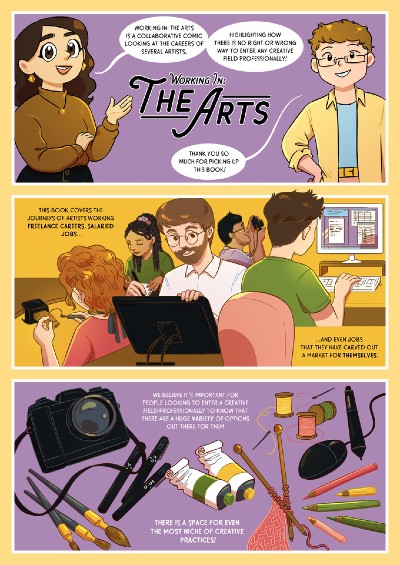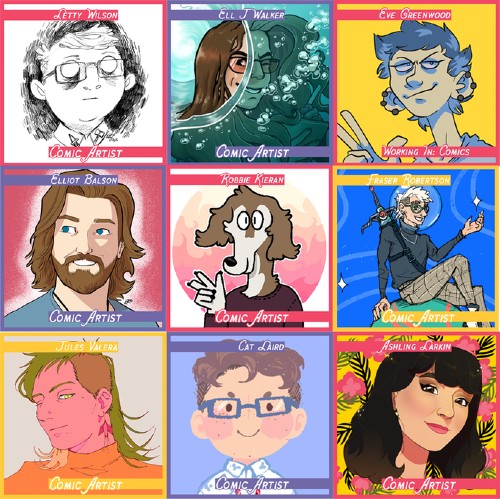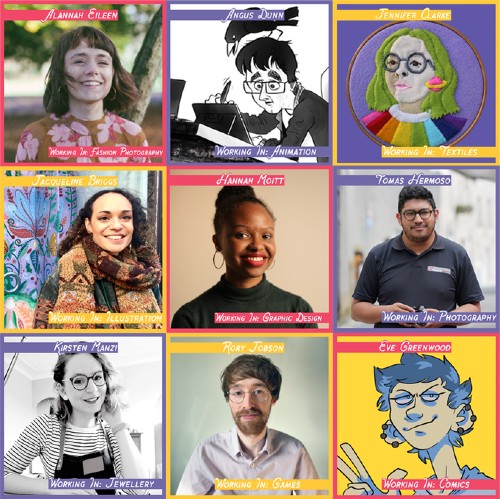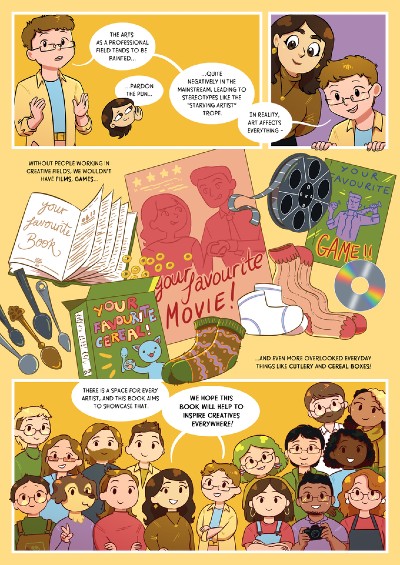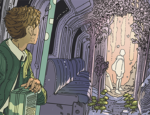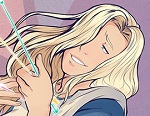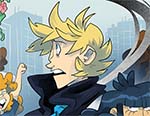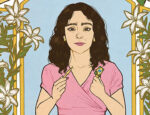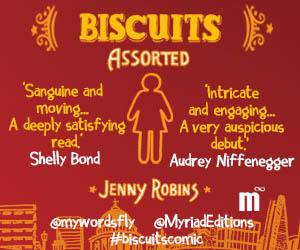Currently funding on Kickstarter, Working In: The Arts is the latest anthology offering from the CHIP Collective. This collection of comics looks to highlight “the HUGE variety of potential career paths and opportunities within the field of the arts” with a series of first-hand practitioner accounts told in sequential art form. I caught up with CHIP’s Ashling Larkin and Cat Laird to talk about the project, its aims, and what they’re hoping readers take away from the stories in its pages…
https://www.kickstarter.com/projects/chipcollective/working-in-the-arts
ANDY OLIVER: Let’s begin with talking about the CHIP Collective. Fill us in on its history to date, its philosophy and the team behind it?
CHIP COLLECTIVE: CHIP (Comics Help Inform People) collective is a comic collective organised by ourselves, Ashling Larkin and Cat Laird. It started out as a concept for making informational comic anthologies that could be distributed to those in need. After Ashling’s Mum’s diagnosis of stage 4 Glioblastoma Multiforme, a rare and aggressive form of brain cancer, we wanted to help others who were going through the emotions of a cancer diagnosis, either for themselves or a loved one, or to help people process the loss of a loved one. We put together our first anthology Living With Cancer: Our Stories and funded it through Kickstarter towards those goals. Following the Kickstarter we also used it as an opportunity to fundraise for Cancer Research UK and help directly that way.
Throughout all our projects it’s been important to us to find stories from real people going through the topic in question. Real life doesn’t always have story arcs and nice neat endings, but the way people interpret what has happened to them in their own words is incredibly powerful and valuable for others to read. One advantage of the medium of comics for our projects is that it’s a different form of accessibility for people to get this information. People who struggle with long text or for whom video is too triggering may have an easier time with the combination of visuals and short text that comics use, depicting real people but not photo-realistically.
AO: The title of your latest anthology Working In: The Arts may seem self-explanatory but talk us through its premise and subject matter?
CHIP COLLECTIVE: Our new project Working In: The Arts aims to highlight that no personal journey to becoming a professional creative is the same. There isn’t a right or wrong way to becoming an artist or a graphic designer, photographer, animator, game developer… Every creative we’ve interviewed or who is illustrating one of the stories has had their unique experience, whether they’re just starting out or have been working for a while. We’re done with the “starving artist” trope that doesn’t benefit anyone and even scares people off! It’s important to know just how working in the field is currently and how to get there through modern avenues. With the rise of social media, improvements in accessibility for creative tools, and different trends coming and going almost week-to-week – the ways to enter creative fields professionally have changed drastically even in the last 10-20 years. How Boomers made their careers in their 20s is going to be drastically different to how modern 20-somethings make their careers today! We want to show people the current options they have.
AO: In terms of the stories told Working In: The Arts has an interesting collaborative approach. Can you tell us about how you’ve gone about bringing these personal accounts to the page? Who are some of the creators involved?
CHIP COLLECTIVE: Working In: The Arts is a team of 17 people, so this project has been hugely collaborative. As with Living With Cancer: Our Stories we wanted to make sure our interviewees were involved every step of the way with their script and artwork to ensure their voice is heard and enhanced by their assigned artist. We began by interviewing each of our 9 creatives, we then used what information they’d given us about their journey into the professional field into a script for them. A few had edits and suggestions to make about individual panels – like in Rory Jobson’s story, in a panel featuring himself as a child, he requested that there were childlike drawings of Sonic The Hedgehog spread around him! Making sure elements like that are included make a world of difference in portraying someone else’s story with authenticity.
Once they approved their finalised script we asked the creatives to send over reference material as well; this included things like photos of them and their work, but also more abstract ideas like a favourite colour scheme for the artist to work with to enhance the feeling of the creative’s true voice being heard. The references and script were then sent off to the artists we assigned to each story. The way we matched the comic artists to the stories also had a lot of thought put into it; for example, we knew that Ell J Walker is good friends with one of the interviewees, Hannah Moitt, so pairing them made a lot of sense!
At every stage of creating the artwork – from thumbnailing, to line art, to flat colours – we’ve passed the artwork over to the respective interviewees to ensure they were happy with the portrayals of their story so far. This is particularly important in cases where the comic artist and interviewee aren’t familiar with each other, and may need a bit more guidance when it comes to the portrayal of real-life people. Collaboration in general is a great opportunity for someone else to look at a piece of work while in progress and offer up a lightbulb moment we all hadn’t thought of yet that just makes things even better!
AO: What areas of the arts are covered in the anthology?
The people we interviewed and areas covered in this anthology are as follows: Alannah Eileen – Fashion Photography; Angus Dunn – Animation; Jennifer Clarke – Textiles; Jacqueline Briggs – Illustration; Hannah Moitt – Graphic Design; Tomas Hermoso – Photography; Kirsten Manzi – Jewellery; Rory Jobson – Games; and Eve Greenwood – Comics.
For this project we had a huge list of people to contact from additional creative areas, such as the performing arts, ceramics, and even makeup – but with 9 interviewees, this project is already quite ambitious, so in the future we would absolutely love to create a second volume exploring those other areas.
AO: Working In: The Arts is currently crowdfunding on Kickstarter. What are some of the rewards backers can expect from the campaign?
CHIP COLLECTIVE: For this Kickstarter we’re keeping the rewards nice and simple – Tier 1 is your name in the “Thank You” page of the book, Tier 2 is the digital PDF of the book, Tier 3 is a physical copy of the book, Tier 4 is both the digital AND physical copies of the book, and Tier 5 is three copies of the physical book, plus the digital PDF.
AO: What are you hoping readers take away from the finished comic?
CHIP COLLECTIVE: Each story in this anthology has a different message, and not all those messages are directed to people involved in one area of creativity specifically. We want readers to take in those messages, and most importantly feel inspired to create the work they want to create, to get the push they may need to get involved in creative communities, and even learn about resources available to them that they may not have been aware of before.
Being an artist right now isn’t easy, it’s a commitment, just like any other job. It’s important to keep learning, to see what people need, to utilise your skills in a way that can make a living but to also create art sensitively and make sure what you’re putting out into the world isn’t harmful. From the start of the pandemic lots of creatives have had at least parts of their revenue cut off due to closures (e.g. teaching workshops and attending conventions) and many of us freelancers aren’t covered by contracts to furlough us or simply aren’t yet eligible for grants to keep us going. One thing that has popped up more, now that connecting with people in real life hasn’t been allowed for the most part, is online collaborative opportunities, spaces, and collectives, like CHIP, to bring people together under a project or theme and support one another in our times of need. Working with others and bringing people joy through art is an indescribable feeling.
AO: Given that we’re in a time when the arts have been so vital in getting people through the pandemic and lockdown – and yet in the UK the Conservative government is proposing to cut arts education funding at a catastrophic 50% level – how important is that celebratory aspect of working in the arts to this collection?
CHIP COLLECTIVE: We don’t believe you can really put a price on the joy that art brings people. We think after a lot of people have only had themselves for company for over a year now the importance of characters, story, laughter, relatability, human connection, has been brought to the forefront of peoples minds. The thing people (especially able-bodied people) need to remember is that for a lot of others isolation and accessibility was a problem long before the pandemic began, and art is how people can express themselves and how others can connect to them too. Creative collaboration and connection is vital, it keeps people alive.
AO: And finally let’s talk about the future. What plans for the future does the CHIP Collective have post-Working In: The Arts?
CHIP COLLECTIVE: After Working In: The Arts, we have a few ideas up our sleeves; some related to Graphic Medicine, like Living With Cancer: Our Stories, some related to other fields of work, and some completely new ideas that we’re very excited about! We’ve already talked about the potential of a Working In: The Arts volume 2, but another career field we’d be interested in covering is working in STEM (Science, Technology, Engineering, Maths) – particularly to help younger, marginalised people get an accessible in-depth, first-person insight into those careers, to inspire them to see those careers as realistic possibilities for them, and to share resources to with them that may help them on their journeys too. We believe there’s a natural air for collaboration between the arts and the sciences, which is why Graphic Medicine as a method of providing information works so well; so that’s something that CHIP would like to continue to explore. The rest is top secret, But we think a LOT of people will be thrilled when they see what we have in store!
For more on the CHIP Collective follow them on Twitter and Instagram.
Don’t forget to back the Working In: The Arts Kickstarter here.
Interview by Andy Oliver





